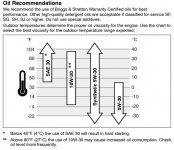My friends, are you joking or off topic...
An oil must not be used for marketing media, labels or personal prints.
Oils are manufactured and classified by worldwide accreditation bodies and when stamped with a classification (SAE, API, ISO, ILSAC...), it is because they have fulfilled a technical assessment package, measurable and reproducible, within the same criteria (no particular impressions).
Nothing prohibits oil manufacturers from saying that theirs is more evolved due to some agent or product within the formulation and using this as a marketing "advantage" and getting more profit, but it's no use for standardized analysis by accreditation bodies, it's a “plus” and the evaluation is at the sole discretion of the client, whose effectiveness or proof has no technical or scientific basis.
The fact is that, for example, all oil classified as SAE 15W30 API SN, regardless of whether the manufacturer says it has this or that extra, fulfills the same function within the evaluation and test package.
Engine manufacturers, when they indicate in the manual the use of an oil, do so because they have tested and proved the efficiency of their engine... some even indicate a specific brand or even label the oil bottle (which is not their manufacture) with your logo ... in this case my logic is that there was a commercial agreement between these parties or actually that "plus" said by the manufacturer, it makes a lot of difference ... conclude as you want.
To objectively answer the question asked at the beginning and considering the various variations in world temperature (remember that this forum is not specific to a country or region), I say that neither mineral, nor semi-synthetic nor synthetic (by option), oil it must be the one indicated by the manufacturer according to the temperature of the working region of the machine.
If the manufacturer's indication allows for some modernity (modernity equals API > SG, SH ... SP), and this changes from mineral to synthetic, then the choice can be made ... but without the change viscosity (SAE) or frequency is changed unless the manufacturer declares this in writing.
In the event that a certain oil is no longer found or manufactured because it has become obsolete, the engine manufacturer must comment on the matter... but it may be exempt due to the age of the machine (in my country, car manufacturers are exempt from any information or supply of parts after 10 years from the end of the manufacture of an engine). In this case, the recommendation is to use an oil of the same viscosity (SAE), with modernity (API) immediately following.
Ex.:
SAE 30 API SF (not found anymore), replace with SAE 30 API SG
SAE 20W50 SJ (not found anymore), replace with SAE 20W50 API SL.

In the table above, whose engine manufacturer is B&S, the recommended oil has a viscosity of 30, which can be semi-synthetic, synthetic or mineral, according to the oil manufacturer.
Can anyone be used? Yes, the manufacturer itself indicates.
However, the manufacturer makes observations regarding ambient working temperatures, consumption and when the API modernity (SF, SG, SH, SH or higher).
If the operation is in a region from -30 to +5°C, the indication is by SAE 5W30... if SAE 30 is used in this same region, the user will be contradicting the manufacturer's indication and serious damages may occur to the machine ... The opposite is also true.
If the working range is between -15 and 30°C, both the SAE 10W30 and the SAE 5W30 (synthetic) can be used, but the operation beyond 27°C with the SAE 10W30 may lead to higher consumption and it advises checking most frequently.
Therefore, however passion one has for a type of oil, the facts and data contradict this position.


